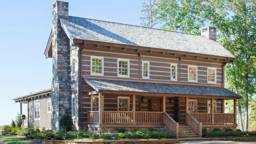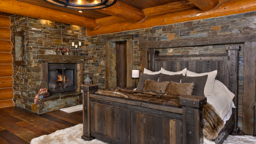
It's not always easy to construct a home on a mountaintop, waterfront or other scenic location. But if you plan carefully and take a few precautions, you can make your dream spot a reality.
One of the great things about log homes is their location. Nine times out of ten, they occupy terrific sites in rural areas where the views are stunning and the property has close ties to nature. Only in resort areas do some of these generalizations break down. There, the properties and views may be even more spectacular; it's just that the neighbors are closer.
Unfortunately, building on a terrific site also can cause some of the biggest challenges. Where you choose to construct your home can have a huge impact on your budget. How you choose to design and orient the house will have a daily impact on your life.
Any number of natural features and site parameters can combine to make a building site's planning complex. Add construction issues, such as access for the concrete mixers and the lumberyard's delivery trucks, and the problem gets stickier. Combine these with log construction where, typically, cranes need to work and huge log trucks show up to deliver their goods, and you have a truly unusual circumstance.
You can accommodate all these needs, of course. However, it requires a good deal of forethought and planning to place and site your new log home just right while preserving the natural features of your property and keeping control of your budget.
So, what makes some building sites more difficult than others? Steep slopes, water frontage, severe weather and hazardous conditions come to mind. Let's look at some specific cases.
It's not unusual to find steep sites just waiting for the perfect log home, but building on a slope can be tricky. The best way to work is to think of the slope as a place where you snuggle into the landscape rather than dominate it. Search for a protected natural "bench" or flat spot in the land that simply invites your home to settle in. Not finding one, create a bench by cutting into the side of the slope and filling in below the home site. Stay away from the top of the hill or ridge, where your views may be fabulous but your home will be exposed to the most severe weather conditions.
An excellent example of how to work with a steep location came along several years ago. With clients at my heels, I tromped more than 80 acres of land exploring feasible building sites. Though possibilities abounded, we kept coming back to the very spot where previous owners had parked a travel trailer for many years. The approach was reasonable for construction trucks and cars, and, with careful cutting and filling, the log home would settle nicely between the slope behind and the rock outcrop in front. We built there.
Today, the owners have walkout basement terraces on both ends of the house, one looking at a Ponderosa pine grove, the other a natural stone grotto. The great room on the backside has a lowered deck and wonderful views across a pristine valley to snow-capped mountain peaks beyond.
The front porch covers a cool sitting area just right for escaping the summer sun or awaiting visitors. A garage, connected by a bridge, is off to one side. The driveway still creates a reasonable approach that gives a wonderful overview before you descend to the compound. The feeling of comfort and correctness is remarkable.
See also How to Buy Land Online

Be it ocean, lake, river or stream, there's nothing quite like a water view. That doesn't mean, however, you must build at its very edge. In fact, most jurisdictions no longer allow you to, because of the environmental impact and the danger of flooding.
For your own safety and security, plan your log home a reasonable distance from the high water mark. Make sure the bottom of the first floor sits at least one foot above that mark or you'll have considerable trouble obtaining flood insurance. Also, to avoid extra-frequent window washing and water damage to the logs, place the home outside the area that normally is subjected to water spray.
Plan your home so you can see and hear the water from both your favorite chair and your bedroom. Establish a protected outdoor space on the leeward side of the building to provide a quiet refuge when waterfront winds blow.
I once designed a beach house on Puget Sound. By stabilizing the bank behind, we created a comfortable beachside "bench" on which to build. The views of the Sound and the mountains beyond were spectacular. But as we noticed before we started building, the winds were as fierce as the glare from the westering sun.
In response, we turned the home's ridgepole parallel to the waterfront, thereby minimizing the amount of wall height exposed to the wind, glare and salt spray. By using a fairly low roof pitch (5:12), we also reduced the height at the gable ends, another strategy for minimizing the impact of the wind.
Now three, 6-foot-wide sliding doors provide full views of the water. On the waterside, a broad deck with a full-length wooden bench protects the building from the strongest storms and accommodates beachside sunbathers in milder weather. Only during the very worst winter conditions does the spray reach the logs. Thanks to some careful planning, this little log building is a gem!
A visit to any mountain resort's web site will show just how densely a community can be planned. (Whistler, British Columbia, and Sun Valley, Idaho, are prime examples of tight places where log buildings abound.) To fully enjoy a home in such an area, proper site planning is key.
Build with views in mind. Open up your home's plan to the mountains and the valleys, but close it off to nearby neighbors.
Also, site your home to make sure snow and rain are shed to the sides of the foundation and can run off downhill. Pay close attention to car parking and snow plowing. Screen outdoor spaces for privacy. Create buffers to screen noise from adjoining properties and nearby roads.
Another example: On a recent project, a half-acre property on which I was working had neighbors close by on both sides, a road and drainfield easement behind and a bluff with tidelands in front. Though the parcel seemed big enough on paper, looks were deceiving; the tidelands and steep slope really cramped the site. The house could only be built along one narrow strip.
With the blessing of a geotechnical engineer, we sited the house just 75 feet from the bluff and designed a wide home with a side entrance. By locating the carport near the entry porch, we made sense of the site and kept the house away from a nearby neighbor.
Today, a landscape buffer reduces road noise; the septic system pumps under the road to the drainfield above and the owners enjoy their remarkable views of the glaciated volcano at the end of the saltwater passage that runs below the bluff. Totally enamored of that view, the occupants barely notice the constraints around them.
Many log home owners escape a lifetime of working in the rain or shoveling snow by moving to "dry country." That's fine, so long as you respect water usage concerns and understand wildfire may be a danger. Others move to mountainous areas where they've always loved to hike and ski. Again, wildfire can be a danger. So can avalanches.
If fire danger is your issue, clear brush and trees in a wide perimeter around your building site. Never let natural vegetation and landscape plantings grow within that perimeter. Instead, use rockscaping and pathways to add interest near your home.
How wide an area should you clear? One rule of thumb I've heard is to create a perimeter that is equivalent to the height of your tallest tree, plus 25 feet. But check with your local fire marshal or volunteer fire battalion chief for specific requirements in your area and advice.
Also, make sure you use a non-combustible roofing material. (Heavy composition shingles, standing seam metal roofing and concrete tile all qualify.) Create a pond or other onsite water storage for firefighting and maintain clear access to it.
If you're building in snow country, look for signs of previous avalanches on your property. Avoid building near gullies or gulches. (One may occasionally send down walls of rock and snow, the other walls of water and debris.) Note trees with lower trunks leaning downhill while upper trunks reach skyward. Typically, these indicate previous avalanche damage. Although it's possible to design "avalanche-shedding" buildings and wedge-shaped retaining walls to split and divert a moving avalanche, there are no guarantees they'll withstand every attack.
Some years ago, with an avalanche report from an expert in hand, clients asked me to design a home that could handle an avalanche. Reluctantly, I did so. In the end, after finally checking the cost of home owner's insurance in an avalanche zone, the owners decided to move their planned building out of harm's way. Though they sacrificed a bit of their view, it just wasn't worth the risk to build in the danger zone.
As you can see, the overall planning for your project extends far beyond its log walls. No matter the size, by designing with your entire site in mind, you're much more likely to end up with an integrated whole that is both an inspiration and a delight.
Spend the time now to think through your own particular site planning issues and trade-offs—particularly if you have a site impacted by codes, covenants, restrictions, nature or neighbors. You'll be glad you did.
Unfortunately, building on a terrific site also can cause some of the biggest challenges. Where you choose to construct your home can have a huge impact on your budget. How you choose to design and orient the house will have a daily impact on your life.
Any number of natural features and site parameters can combine to make a building site's planning complex. Add construction issues, such as access for the concrete mixers and the lumberyard's delivery trucks, and the problem gets stickier. Combine these with log construction where, typically, cranes need to work and huge log trucks show up to deliver their goods, and you have a truly unusual circumstance.
You can accommodate all these needs, of course. However, it requires a good deal of forethought and planning to place and site your new log home just right while preserving the natural features of your property and keeping control of your budget.
So, what makes some building sites more difficult than others? Steep slopes, water frontage, severe weather and hazardous conditions come to mind. Let's look at some specific cases.

Building on Steep Slopes
It's not unusual to find steep sites just waiting for the perfect log home, but building on a slope can be tricky. The best way to work is to think of the slope as a place where you snuggle into the landscape rather than dominate it. Search for a protected natural "bench" or flat spot in the land that simply invites your home to settle in. Not finding one, create a bench by cutting into the side of the slope and filling in below the home site. Stay away from the top of the hill or ridge, where your views may be fabulous but your home will be exposed to the most severe weather conditions.
An excellent example of how to work with a steep location came along several years ago. With clients at my heels, I tromped more than 80 acres of land exploring feasible building sites. Though possibilities abounded, we kept coming back to the very spot where previous owners had parked a travel trailer for many years. The approach was reasonable for construction trucks and cars, and, with careful cutting and filling, the log home would settle nicely between the slope behind and the rock outcrop in front. We built there.
Today, the owners have walkout basement terraces on both ends of the house, one looking at a Ponderosa pine grove, the other a natural stone grotto. The great room on the backside has a lowered deck and wonderful views across a pristine valley to snow-capped mountain peaks beyond.
The front porch covers a cool sitting area just right for escaping the summer sun or awaiting visitors. A garage, connected by a bridge, is off to one side. The driveway still creates a reasonable approach that gives a wonderful overview before you descend to the compound. The feeling of comfort and correctness is remarkable.
See also How to Buy Land Online

Building by the Water
Be it ocean, lake, river or stream, there's nothing quite like a water view. That doesn't mean, however, you must build at its very edge. In fact, most jurisdictions no longer allow you to, because of the environmental impact and the danger of flooding.
For your own safety and security, plan your log home a reasonable distance from the high water mark. Make sure the bottom of the first floor sits at least one foot above that mark or you'll have considerable trouble obtaining flood insurance. Also, to avoid extra-frequent window washing and water damage to the logs, place the home outside the area that normally is subjected to water spray.
Plan your home so you can see and hear the water from both your favorite chair and your bedroom. Establish a protected outdoor space on the leeward side of the building to provide a quiet refuge when waterfront winds blow.
I once designed a beach house on Puget Sound. By stabilizing the bank behind, we created a comfortable beachside "bench" on which to build. The views of the Sound and the mountains beyond were spectacular. But as we noticed before we started building, the winds were as fierce as the glare from the westering sun.
In response, we turned the home's ridgepole parallel to the waterfront, thereby minimizing the amount of wall height exposed to the wind, glare and salt spray. By using a fairly low roof pitch (5:12), we also reduced the height at the gable ends, another strategy for minimizing the impact of the wind.
Now three, 6-foot-wide sliding doors provide full views of the water. On the waterside, a broad deck with a full-length wooden bench protects the building from the strongest storms and accommodates beachside sunbathers in milder weather. Only during the very worst winter conditions does the spray reach the logs. Thanks to some careful planning, this little log building is a gem!

Building Close to Neighbors
A visit to any mountain resort's web site will show just how densely a community can be planned. (Whistler, British Columbia, and Sun Valley, Idaho, are prime examples of tight places where log buildings abound.) To fully enjoy a home in such an area, proper site planning is key.
Build with views in mind. Open up your home's plan to the mountains and the valleys, but close it off to nearby neighbors.
Also, site your home to make sure snow and rain are shed to the sides of the foundation and can run off downhill. Pay close attention to car parking and snow plowing. Screen outdoor spaces for privacy. Create buffers to screen noise from adjoining properties and nearby roads.
Another example: On a recent project, a half-acre property on which I was working had neighbors close by on both sides, a road and drainfield easement behind and a bluff with tidelands in front. Though the parcel seemed big enough on paper, looks were deceiving; the tidelands and steep slope really cramped the site. The house could only be built along one narrow strip.
With the blessing of a geotechnical engineer, we sited the house just 75 feet from the bluff and designed a wide home with a side entrance. By locating the carport near the entry porch, we made sense of the site and kept the house away from a nearby neighbor.
Today, a landscape buffer reduces road noise; the septic system pumps under the road to the drainfield above and the owners enjoy their remarkable views of the glaciated volcano at the end of the saltwater passage that runs below the bluff. Totally enamored of that view, the occupants barely notice the constraints around them.

Building in Hazardous Areas
Many log home owners escape a lifetime of working in the rain or shoveling snow by moving to "dry country." That's fine, so long as you respect water usage concerns and understand wildfire may be a danger. Others move to mountainous areas where they've always loved to hike and ski. Again, wildfire can be a danger. So can avalanches.
If fire danger is your issue, clear brush and trees in a wide perimeter around your building site. Never let natural vegetation and landscape plantings grow within that perimeter. Instead, use rockscaping and pathways to add interest near your home.
How wide an area should you clear? One rule of thumb I've heard is to create a perimeter that is equivalent to the height of your tallest tree, plus 25 feet. But check with your local fire marshal or volunteer fire battalion chief for specific requirements in your area and advice.
Also, make sure you use a non-combustible roofing material. (Heavy composition shingles, standing seam metal roofing and concrete tile all qualify.) Create a pond or other onsite water storage for firefighting and maintain clear access to it.
If you're building in snow country, look for signs of previous avalanches on your property. Avoid building near gullies or gulches. (One may occasionally send down walls of rock and snow, the other walls of water and debris.) Note trees with lower trunks leaning downhill while upper trunks reach skyward. Typically, these indicate previous avalanche damage. Although it's possible to design "avalanche-shedding" buildings and wedge-shaped retaining walls to split and divert a moving avalanche, there are no guarantees they'll withstand every attack.
Some years ago, with an avalanche report from an expert in hand, clients asked me to design a home that could handle an avalanche. Reluctantly, I did so. In the end, after finally checking the cost of home owner's insurance in an avalanche zone, the owners decided to move their planned building out of harm's way. Though they sacrificed a bit of their view, it just wasn't worth the risk to build in the danger zone.
As you can see, the overall planning for your project extends far beyond its log walls. No matter the size, by designing with your entire site in mind, you're much more likely to end up with an integrated whole that is both an inspiration and a delight.
Spend the time now to think through your own particular site planning issues and trade-offs—particularly if you have a site impacted by codes, covenants, restrictions, nature or neighbors. You'll be glad you did.







_11868_2023-12-20_08-12-256x288.jpg)



